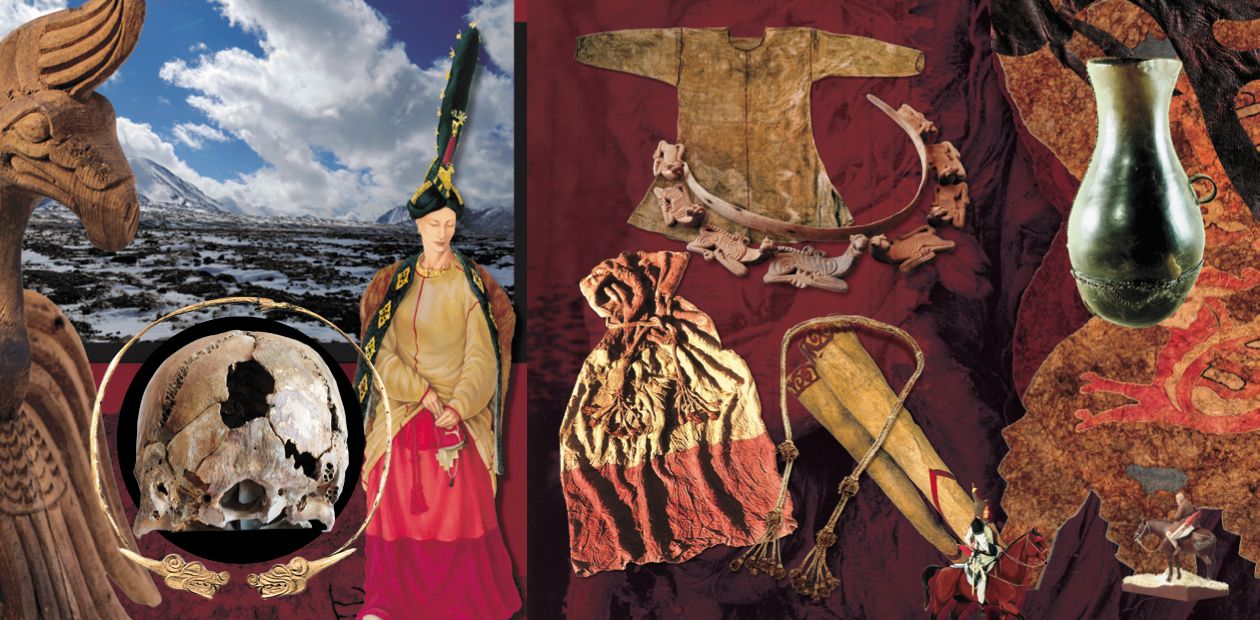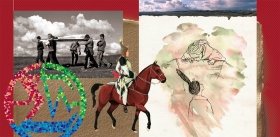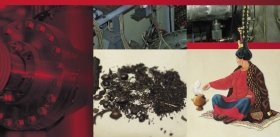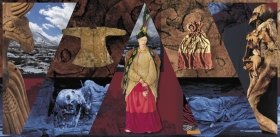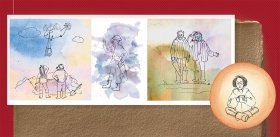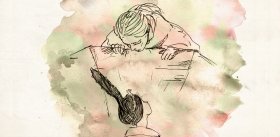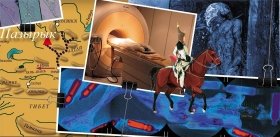A Different Archaeology
Pazyryk culture: a snapshot, Ukok, 2015
Times destroys everything. The more surprising it is when something living – things made of organic materials – comes to us from high antiquity.
It can take years to speculate about what the discovered “decorations” served for and what they decorated or, driven to despair by the failure to solve this riddle, to refer to the enigmatic thing as “an object with an unknown function” – and only organics can establish connections between scattered findings.
Fabrics and fur, felt and leather, threads and pelts, and sometimes, lo and behold, the human body itself, carefully embalmed and preserved against all odds, dot the i’s and cross the t’s, and you are heart-struck by what you’ve seen…
For the first time this happened in Ukok. After we came across the “frozen graves” of the Pazyryk culture, archaeology for us split into the archaeology we had known before 1990 and the one that we knew after.
I think this is a different archaeology
Many times, I have seen splendid objects from the Pazyryk graves in the Hermitage and had a lucky opportunity to work with them. Our problem though is that we yearn not just to see but to find. The context of a finding gives you much more than just an item from a museum collection – it is the connection of the things within the space of the tomb and on the body of the buried. Then, a museum collection turns into a source of rare and exclusive information, and you look at these things at a different angle and grasp the function of the objects, unknown before. How could these felt helmets, similar to the headgear of Tibetan lamas, come into the minds of Pazyryk culture researchers? Or the long skirts of Pazyryk women, their wigs, or men’s trousers and fur coats with “tails”? We would still be lost in conjectures, and there would be no end to tales. Clothes were not just things to wear, as they are now, when we all wear something more or less similar – Turkey and China dress half the world. Back in those legendary times, a costume was akin to an identity card. It contained both the right to live and the reason to die.
Post factum, you find the depictions of Sakas pointed hats on Persepolis reliefs and on the gold images of Scythian warriors, as well as many other things that will take many pages to enumerate and describe. To search for analogies, you only have to be a bright student. But first of all, the thing should have been discovered. The Pazyryk helmets ornamented with animal figurines remain unique – and they are real. These are not drawings or depictions, these are things, and these things had owners.
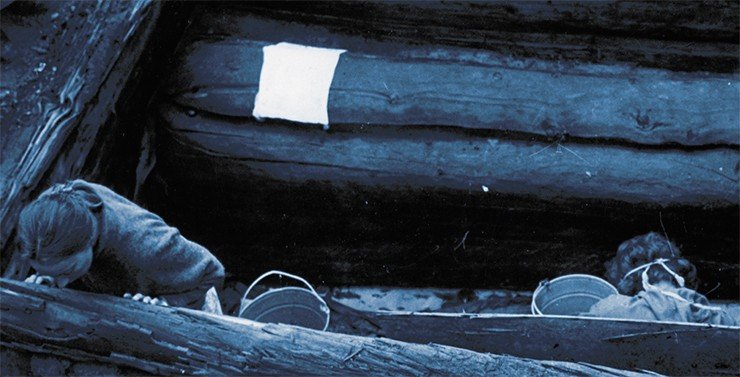
Here another question comes up – the personality of the buried. The things they owned point out that each of them was a person worthy of a separate story.
“Oh time, the destroyer of things…”
No matter how similar the objects that accompanied the Pazyryks may seem, no matter how similarly they were dressed, the integrity of organic objects allows us to see that each person possessed an unmatched combination of objects ordinary for their culture. These things bore their individual marks, the traces of the spent life. Even the bodies, when preserved, differed not only in physical features but also in the tattoos.
Over 25 years between our excavations in Ukok and the latest excavations by S.I. Rudenko. Over 80 years between P.K. Kozlov’s explorations in Noin-Ula and the Russian-Mongolian expedition to this monument. 25 years between our first research in Ukok and the results of paleogenetic studiesToday, thanks to the new methods that have come to archaeology, we dive into the story of each of them and can see that there are no minor characters.
Organic matter reminds, warns and conjures: you cannot measure ancient cultures by your own yardstick; you are sure to go wrong. “This is so uncomfortable” (of women’s wigs) or “It’s impossible to wear them” (of short trousers or long felt stockings) or “One must be freezing in these thin shirts!” What do we know of cold and comfort? Even now, every culture has its own ideas about them. When, driven from the tumulus by cold shower, we ran for the protection of our tents, Tuvinian children, who had been watching us all day, did not go anywhere, completely ignoring this cataclysm. In fact, they had no idea we had run off because of the rain.
Archaeology comes into you as a feeling. The feeling of an alien, different life. We lived on the same earth and saw the same sky. In theory, this is true. But is it really so? Actually, they had a different earth and a different sky. We see everything around us differently. We have come to this world with different knowledge.
We have somehow got used to the idea that the pharaohs’ graves are a piece of ancient Egypt, together with its dried flowers and preserved fragrances. However, this is something out of the ordinary – this is EGYPT, this is what Napoleon said before the Battle of the Pyramids: “Soldiers! Forty centuries are looking at you!”… Here, in Pazyryk, there are mountains, steppes and forgotten by everyone, hardly noticeable graves of the people who did not even leave their name. All of a sudden, you come across something amazing – their “frozen” burial grounds, and it is an information shock. If you get such a gift, you are responsible for it for the rest of your life, as it turned out. Of course, many specialists contribute to it: anthropologists, anatomic pathologists, textile specialists, paleozoologists, chemists, geologists, dendrochronologists, restorers, bone and wood carvers, and still…Everybody do their bits of work, make discoveries, and you draw on these data and assemble a big picture from them. It grows and changes but the main thing happened when the tomb was opened and in the couple of summer months spent in it and with it. We all know that the same facts can be interpreted differently, and their number never builds up into better quality.
Time goes by, but everything that happened then is still of interest not only to you and your colleagues but also to those who were not even born in 1990.
A kurgan like a kurgan
Twenty years ago, on the Ukok Plateau in the Altai Mountains, one of the greatest discoveries of the national archaeology of the late 20th century was made: an intact “frozen” burial of Pazyryk culture dated by 5th-3rd century B.C., which contained a mummy of a noble woman.
Tumulus 1 of Ak-Alakha 3 burial ground, built of stones, was 18 meters in diameter. Such kurgans are considered medium-size in the Pazyryk culture (small kurgans are approximately 5—12 meters and the large ones can be up to 60 meters). The kurgan stones had been used for modern construction works; therefore, the mound had been destroyed. Next to it was a kurgan of a smaller size, whose mound had also been damaged. Its investigation showed that it belonged to the Turkic time.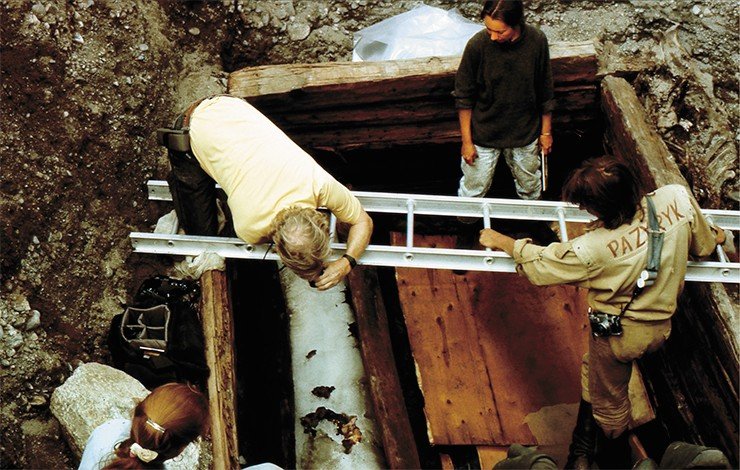
As usual, all the work of removing the remains of the mound and clearing the kurgan area was done by hand. In the less damaged eastern part, we managed to trace the structure of the mound: a compact layer of large stones was put in the foundation while smaller stones and pebbles formed the upper part of the burial construction. The edges of the mound were heavily grassed; once the grass was removed, a round wall made of large stones appeared.
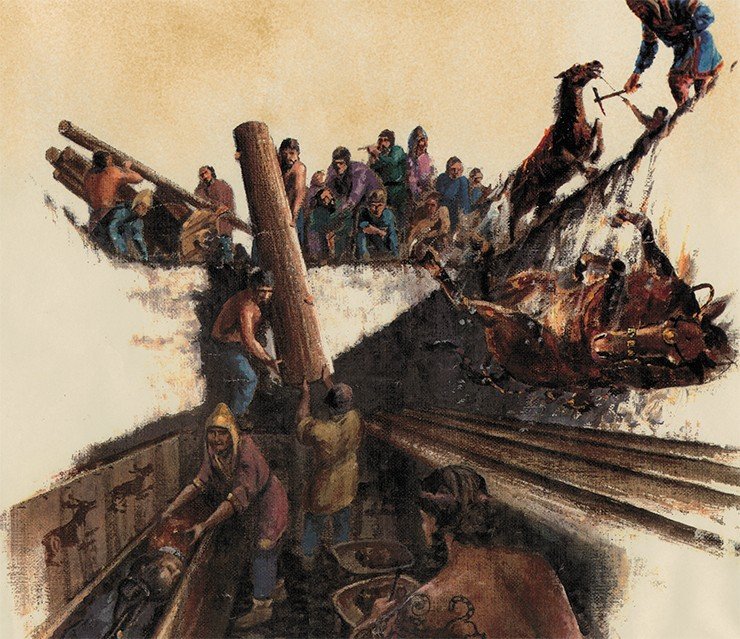
According to the Pazyryk funeral ceremony, a larch framework was built at the bottom of the burial pit, and the mummified dead lying on a block or on a wooden bed was placed on top of it. The mound erected over the grave consisted of stones, boulders and pebbles and was water-permeable. Summer and autumn rains and soil water flooded the larch sepulchral vaults; the water froze during the winter and often did not melt in the summer. The permafrost rocks, which occur in the Ukok region, are known to have existed there for ages; they are of intermittent and insular nature and spread over approximately 60—80% of the entire area. The permafrost soils are about three meters deep, and the depth of the burial pits is the same. It was impossible to dig a deeper pit—even modern iron spades rebound from the frozen ground.
Tumulus 1 of Ak-Alakha 3 site looked like a typical burial monument of Pazyryk culture. The only distinguishing feature was that it stood alone whereas, as a rule, the Pazyryk burial grounds feature a chain of kurgans stretching from the north to the south.
“Frozen” graves are a most singular phenomenon in archaeology, which originated thanks to a unique combination of natural conditions and cultural traditions of the ancient Pazyryks.In Ukok, sepulchral vaults were made in the permafrost. The buried bodies were put, as it were, into a refrigerator, where they have survived to this day. The Pazyryk people might have done this on purpose: they were certainly aware of the cold’s ability to prevent decay – the knowledge they had gained from their everyday life.
Thanks to the rocks frozen for many years, these tombs have kept intact not only the bodies of the buried but also objects made of organic materials. Therefore, “frozen” tombs are much more informative than ordinary archaeological sites. The discoveries made on the Ukok Plateau were unique because for the first time during more than a hundred years of explorations untouched “frozen” burials of the representatives of Pazyryk nobility have been found
It was the first undamaged “frozen” sepulcher of an outstanding representative of the Pazyryk culture, discovered over the whole period of its study, which started in the mid-nineteenth century. The first thing that made an unforgettable impression was the fact that the burial-place had been untouched. The man accompanying the woman into the other world “got in the way” of the robbers, who penetrated into the sepulcher through a small hole in the center of the mound; they got satisfied with destroying the man’s tomb and did not notice the large larch vault under it.
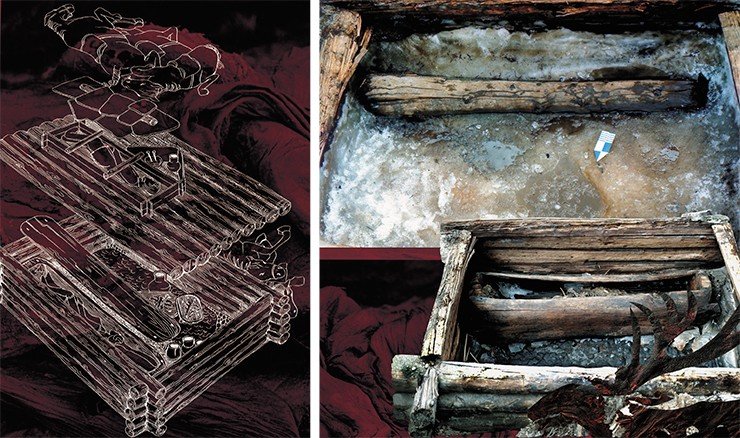
The man’s burial-place located at the intersection of the main sepulcher is not at all typical of Pazyryk culture: it is truly exceptional. Taking into account the fact that the man was killed with a blow of a blunt object on the back of the skull, it can be claimed with a high degree of certainty that here we deal with a tradition of “simultaneous” death, when a person leaves this world not alone but in the company of people he or she needs in the other world. Together with the man, there was the body of a teenager, also discovered in the sepulcher, whose cause of death remained undetermined for lack of anthropological material; also, there were the bodies of three racing horses. This accompanying vault immediately shows how important this woman was for her fellow tribesmen.
Companions to the “other” world
Based upon what we know, this double burial was arranged immediately after the main burial of the mummified woman in the larch vault.
After the excavation of the tumulus, all the attention was obviously focused on the woman mummy, while the robbed burial and people buried in it happened to be in her shadow. It was time for them to come out of it as they were part of the same story and had been tied (though it was not yet clear in what way) to that woman, whose rebirth generated so much interest.
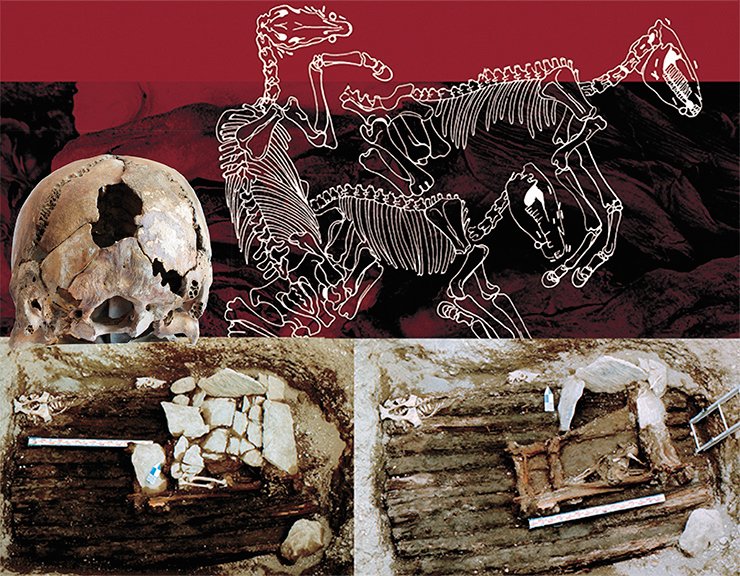
Actually, judging by the diggings of the “tsar” burials of the Pazyryk burial ground, the graves often contained the bodies of two people—a man and a woman—and it was hardly the case of living a long and happy life together and dying on the same day. Undoubtedly, one of the two was killed to accompany the dead one.
Ultimately, the people buried on the ceiling of the Pazyryk vault had fulfilled their mission: they saved and preserved the incorruptible body of a respected woman. But what were they, inferior and dependent? And what was she?
The burial on the ceiling of the Pazyryk vault differs from the typically Pazyryk burials in the funeral ritual but not in the funeral inventory—it was similar though poorer. The general picture that we have today allows us to say that inside the Pazyryk community was a dependent part of the population, who buried the dead in stone boxes. In academic literature, they are referred to as Kara-Kobins.
Frozen time
The mummification techniques used by the Pazyryks were diverse. In easier cases, only the abdomen was dissected, through which all the internal organs were removed, and the freed cavities were not even filled. This technique was applied for the mummification of the man from the Verkh-Kaldzhgin 2 burial ground (Ukok, excavation by V.I. Molodin, 1995). If, instead of the mummy, only the skeleton of the man had been discovered, it would have been impossible to tell that he had been mummified.
Note that Ukok has always been a winter pasture. People used to come here together with herds of horses and sheep in late October and left for summer pastures in June. It must have been at that time that they buried those who had not survived the winter. The Pazyryks left the burials of their relatives in Ukok, and in so doing they secured this area for themselvesThese facts provide strong grounds to believe that mummification was part of the Pazyryk culture. All the dead bodies were mummified, but very few have been preserved to this day. The reason for this amazing preservation is that all the Pazyryk mummies, including the woman from the Ak-Alakha kurgan, were discovered in ice. It is the ice of the “frozen” graves of Gorny Altai that is responsible for their preservation, and not the mummification techniques, which were far from perfect.
The mummified body of the woman from an Ak-Alakha tumulus had spent over 2,000 years in an ice cube formed by the larch log structure 3.60×2.30×1.12 meter in size. According to pathologists, the degree of preservation of the body suggests that its frozen condition was permanent, i.e., it did not thaw from time to time.
On the way to eternal life The body of the woman had been mummified. For this procedure, the skull bones and some vertebrae had been separated from the body. In the lower part of the occipital lobe, a trephine opening (about 4.5 cm in diameter), through which the brain had been removed, was discovered. The thin bones between the eye sockets had been broken; there was a hole, about 2 cm in diameter, connecting the nasal cavity and maxillary sinus. In pathologists’ opinion, eyeballs and the mucus of the nose and sinus nasales could have been removed through this hole. The gristle parts of the ribs and the breastbone had been removed; the abdomen had been dissected and cleared of internal organs (anatomic pathology studies of the woman mummy were performed in 1993 by Doctor R. Hauri-Bionda and his assistant W. Blater from the Institute of Forensic Medicine, University Zurich-Irchel, at the Institute of Archaeology and Ethnography, Siberian Branch, Russian Academy of Sciences).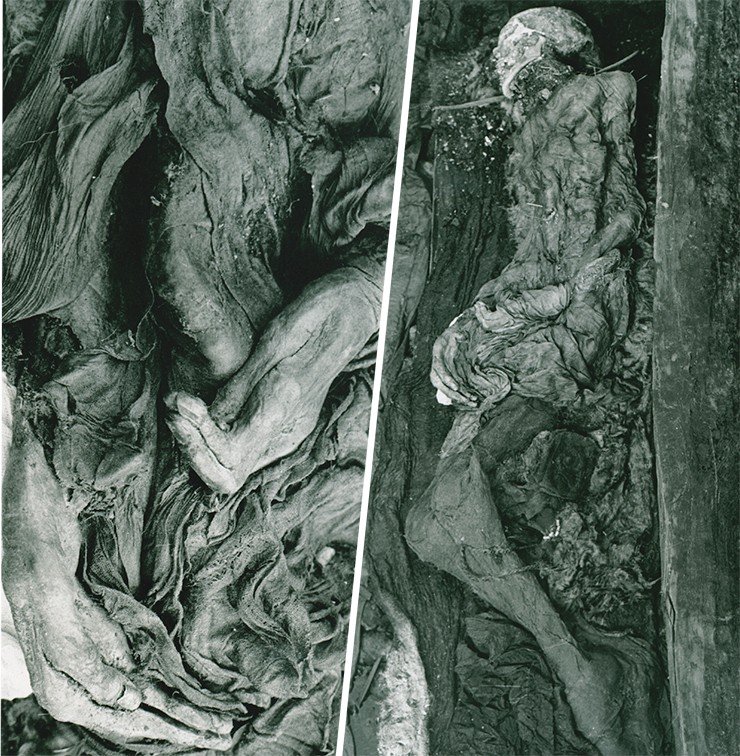
The body mummification techniques are similar to those of an embalmer – the lost bodily volume is restored using hygroscopic materials. All cavities freed up after the dissection (the skull, breast, abdomen, pelvis, neck and arms) had been stuffed with dry grass growing on Ukok: sedge and cereals pulled together with the roots (the aromatic seeds, grasses and plants from the burial and from the mummy stuffing were identified at the Herbarium of the Botanical Gardens SB RAS by Ye. Kotolyuk, I. Artemov and M. Lomonosova), wool, tiny roots and a black substance resembling peat in consistency. This substance, examined by V. Stepanov, Senior Research Worker at the Institute of Bioorganic Chemistry SB RAS, appeared to be the processed tissue of the internal organs. In this way, the internal organs of the buried woman came back inside the body after they had been transformed into a homogenous mass.
All the above-named actions, however, did not suffice to mummify and preserve the body because neither of these components have antibacterial or preserving properties. The Х-ray fluorescence analysis of a fragment of the mummy’s skin, conducted at the Boreskov Institute of Catalysis SB RAS (these and other examinations of the material composition of the findings were conducted by Doctor of Chemistry V.V. Malakhov, A.A. Vlasov, L.M. Pliasova and Candidate of Physics and Mathematics I.A. Ovsiannikova), showed that the conserving agent that was able to preserve the body until the burial was mercury, traces of which were discovered on the mummy’s body
Mummification of dead bodies may be attributed to the Pazyryk beliefs that a person’s life after death was closely connected with the condition and life of the body. From a practical point of view, mummification was necessary to preserve the dead bodies for the long period between the time of their death and their funeral.
The mummies into which the Pazyryk people turned their dead are evidence of an ancient ritual, vividly demonstrating the attitude of those people to life, death and immortality. The mummies of the Pazyryk people are an exceptional cultural phenomenon, an ancient Iranian tradition miraculously preserved till the present day. The Persian and Scythian kings must have been mummified in the same way as the Pazyryk people.
The mummies carry a lot of hidden information, some of which has already been decoded; however, a lot remains unknown because of a lack of appropriate methods and approaches. The mummies may contain the kind of information we cannot be aware of at present.
Illness as a gift
Today, twenty years after the mummy was found in Tumulus 1 at Ak-Alakha 3 site, we have found out something that changes our idea of the buried woman and of the Pazyryk society at large. We have found out the reasons of her death, which to a large extent explain her life.
In the opinion of the pathologists who examined the mummy’s condition, the body may have been preserved for two to three months, or half a year at the most. The funeral took place in the middle of June, which is attested by the last fodder of one of the horses buried together with the woman; it consisted of twigs whose yearly rings had formed new cell cultures typical of that time of the year. The analysis of the pollen showed that the burial took place under the conditions typical of spring in the Altai highlands.
Found in the ice was a larch vault, and lying behind its northern wall were six horses in beautiful harness, decorated with numerous wooden depictions of gryphons, covered with gold foil, with felt saddle blankets and tassels woven of woolen threads. On the floor of the burial chamber, covered with a felt carpet, there were two wooden tables with pieces of meat (forced into one of them was an iron knife), as well as ceramic, horn and wooden vessels filled with drinks—the buried was on her way to the gods’ feast.The woman’s body lay in a larch block, decorated with leather appliques depicting deer with huge branching horns; the lid of the block was fastened with bronze nails. The block itself was filled up to the lid with nontransparent ice.
The woman was lying on thick soft felt, in the position of sleeping on the right side, with slightly bent legs. She was dressed in a long silk shirt of a golden color with red trimmings, a heavy woolen skirt sewn from red and white strips, belted by a tasseled thick string woven of woolen threads. On her feet were white felt high boots-stockings with red applique along the top. On her head she had a wig and a wood carved decoration covered with gold foil. Around her neck was a wooden breastplate with carved figurines of winged leopards, near her waist was a felt bag with a small mirror in a wooden frame, decorated with a carved depiction of a deer, a handful of blue glass beads and a few larger beads
Based on these data, it can be concluded that the woman died either in January or in March. In any case, she did not die immediately from a head injury, which would have rid her of pain and suffering. Instead, she must have lived another three to five months, being bedridden all the time. Without any doubt, before she died she had been in critical condition. Here, then, it is quite appropriate to remember how the well-known researcher of Yakut shamanism A. A. Popov (2006) described the last days of shamans. He pointed out that they usually died in terrible pain.
Imagine a woman exhausted by her illness and suffering from the most severe pain, who had to lie for several months in a winter log cabin poorly heated with pressed dung. Judging by the winter log cabins one can see on Ukok today, modern winter dwellings do not differ greatly from those the Pazyryk people used to live in. Moreover, they are located in the same places as in the past. For centuries cattle breeders have unmistakably chosen the most convenient and suitable hidden places for their winter camps, which are protected by the ancient moraines from the strongest winter winds that blow out the snow and free the pastures for the cattle.
Every culture has its own smell. The Pazyryk culture is flavored with a slight aroma of hemp, whose seeds were uncovered in the Great Pazyryk Burial Mounds. The seeds were found in a decorated leather flask and on smoked stones lying inside a bronze kettle. The Pazyryks presumably had a habit of inhaling the fumes of burning hemp, which produced a light narcotic effect. The artifacts found in all the Great Pazyryk Burial Mounds suggest that the ceremony was carried on as Herodotus once described. He reported that the Scythians took hemp seeds and went into a felt yurt. Then, they placed the seeds onto red-hot stones. The steam and smoke from the seeds was so strong that no Hellenistic bath could compare with this Scythian “bath.” The enjoyment made the Scythians cry out very loudly (Herodotus, Book IV, 75). This habit was fatal for those who inhaled the fumes from burning hemp seeds over bronze kettles (such a kettle was found in the Second Pazyryk Burial Mound) because they were gradually poisoned by the toxic evaporations containing copper compounds (Polosmak and Trunova, 2004). Another smell typical of Pazyryk culture was coriander, whose seeds were used for their aroma. Coriander seeds were kept not only in bags; they were also found on a stone plate near the head of a deceased woman from Tumulus 1 at the Ak-Alakha-3 cemetery.The fragrant aroma of coriander was meant to mask the odor of decay and was a gift to the deity to whom the deceased was sent. The felt pillow stuffed with an aromatic plant, which was found under the head of a man from Tumulus 1 at the Verkh-Kaldzhin burial site suggests a great role of fragrant substances in the Pazyryk culture. There was another strong aroma, that of ziziphora, which accompanied the Pazyryks on their way to the “Heavenly Pastures.”
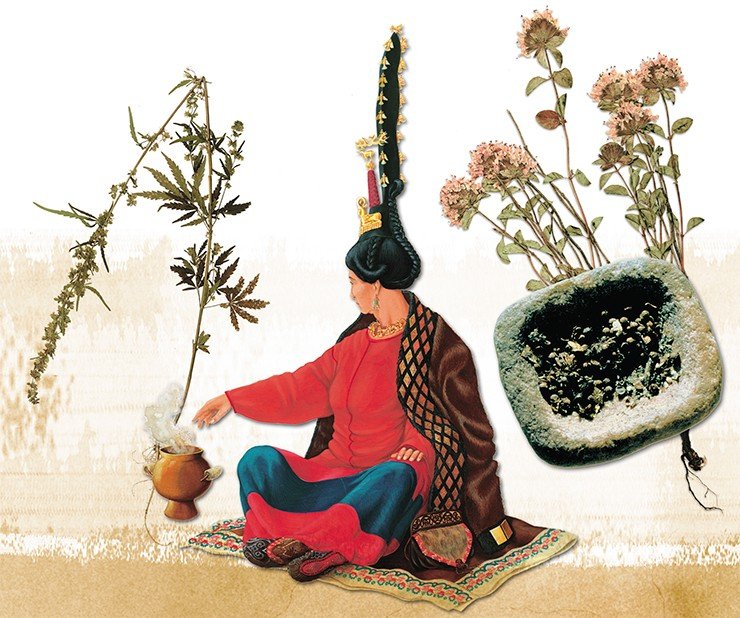
The paleopathological analysis of the anthropological material from the Pazyryk sepulchers on Ukok has shown that almost all the bones of the people from Ukok reveal the symptoms of a severe physiological stress: the population was constantly exposed to the local extreme environment.
Using these data, we may conclude that almost all Pazyryk people suffered from different diseases which, to a certain extent, limited their physical abilities, making them overcome pain every day. Besides, some of them suffered from the diseases that required constant help and care from others. The causes of these diseases were connected not only with the specific features of the environment but also with the lifestyle of horsemen and breeders.
The magnetic resonance imaging (MRI) test allowed the researchers to detect in the mummy a number of foci abnormalities with an enhanced magnetic resonance signal intensity. There can be several explanations of the origin of these foci; however, it is clear that they point to a rather serious disease which could have caused death. We shall mention two most common hypotheses of the origin of fatal foci, the more so because the MRI signal clearly shows their separation into two groups. According to one hypothesis there was osteomyelitis as a manifestation of a general septic process; the other hypothesis is that the woman had cancerWhat made the tribesmen first take care of the sick woman and then bury her in a way that women were rarely buried in that society – with full honors? The results of the computer tomography of the mummy supported our hypothesis, based exclusively on archaeological materials, that the woman buried in Tumulus 1 of Ak-Alakh-3 site had enjoyed a special status and was somebody we can call the Spirits’ Chosen. The hypothesis was also supported with new facts.
Reconstruction based on the medical data(conclusion on life and death)*
When she was a little over twenty years old, she developed another serious disease, breast cancer, which was devouring her during the last five to seven years of her life. She arrived at the winter camp on Ukok in October in critical condition; in modern terms, she had the last, terminal stage of breast cancer. This stage is characterized by severe pains and the highest level of intoxication leading to the loss of physical strength.
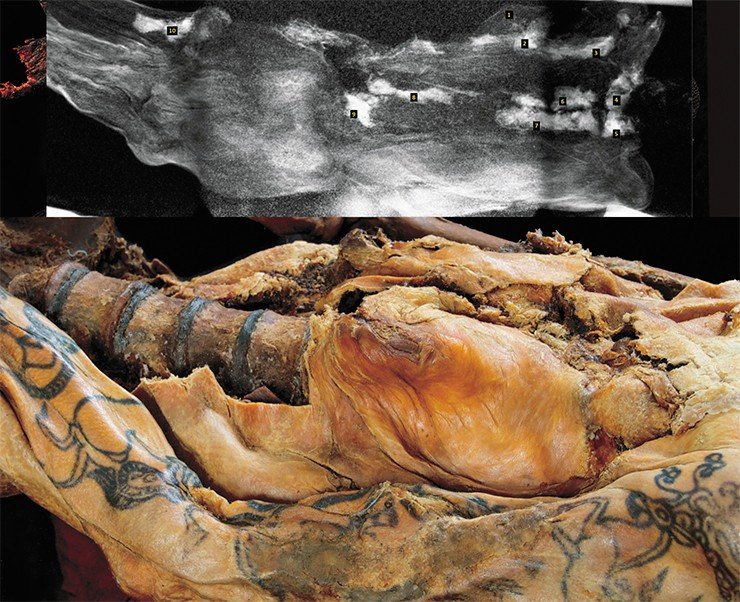
Being in such a state, she must have fallen off the horse and received severe injuries. She fell on the right side of the body, with the right temple, right shoulder, and the right hip all having suffered in the fall. However, her right arm did not suffer because it was held tight to the body. Probably, by that time her arm had stopped functioning, which is attested by the pathological changes in its tissues, reflecting, in fact, the process of decay in the living tissue. However, even after having suffered such a trauma, she may have stayed alive, for there are some lifetime edematous changes in the inguinal and axillary regions.
Medical data obtained by Dr.Sci.(Med.) A.Yu. Letyagin and Cand.Sci.(Phys.-Math.)A.A. Savelov in 2010 at the International Tomography Center SB RAS.
From numerous ethnographic sources it is well-known that the birth of a shaman is preceded by a long-term illness of the person. As early as in the end of the 19th century, some scientists claimed that Indo-European shamanism had been born out of a real illness; only later shamans started falling into real trance (Wilke, 1887). We can suppose that it was the developing illness that formed the basis for the calling of the “woman from Ukok,” which limited her physical abilities but broadened her capacity for inner concentration and meditation, and made her behave ascetically. The illness, which had an unexplainable supernatural origin and caused unbearable suffering, could have made her stand out of the crowd. M. Eliade vividly described it as follows: “She [the woman] experienced the sacred with a greater intensity than the rest of the society” (Eliade, 1964). In addition, she, of course, had some outstanding personal traits, which would have become apparent anyway. Without any doubt, what we deal with here is a clear combination of unique character traits with the consequences of a severe disease.
A mummy is considered to be much more informative of a person’s physical appearance than a skeleton but this is not true. For example, a detailed anthropometric examination of the woman mummy from the Pazyryk Tumulus 1 of Ak-Alakha 3 burial site became possible only because not the whole of the dead body had been preserved to the same degree and some bones of the skeleton including the skull were accessible for measurements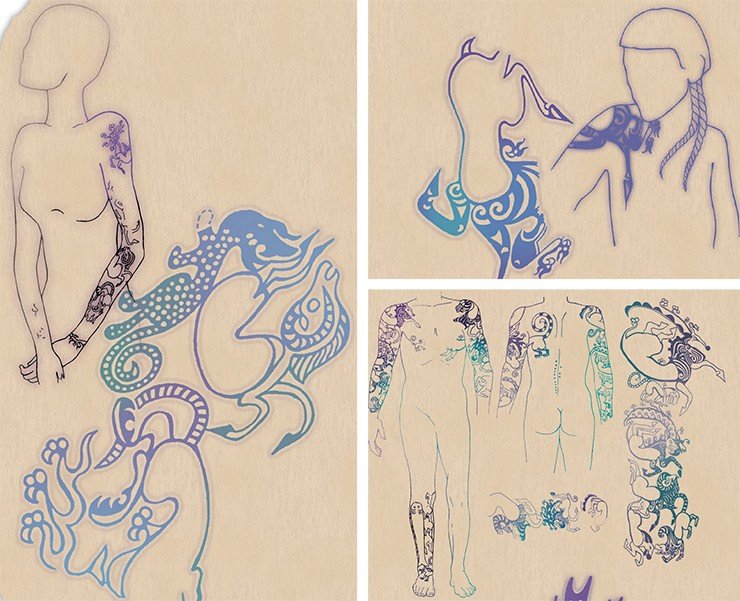
What deserves special attention is that she might have used painkillers, with evident consequences. In the ancient cultures which left written evidence, the following substances were used as painkillers: wine, opium, hashish, henbane, mandrake extract, wolfsbane, and Indian hemp (Mirskiy, 2000). The Pazyryk people were familiar with hemp and with its properties. The hemp seeds discovered in the “kingly” burials were used in the ritual as incense.
The Pazyryk people suffered from different types of chronic polyarthritis, which often manifested itself in deforming arthrosis of the major and minor joints of the upper and lower limbs. They also had osteochondrosis, i.e. deformation of joint surfaces of vertebra, and vertebral ankylosis, i.e. deformation of the spinal cord ligaments, sometimes accompanied by ankylosing spondylitis. Besides, single cases of ankylosing spondylitis of the ligaments of sacroiliac joints and cases of spondylolysis, i.e. deformation of the vertebral arch, were detected (Chikisheva, 2003).Constant inhaling of hemp vapor seems to have become a dire necessity for the woman (Polosmak, Trunova, 2004), and she often found herself in the state of altered consciousness. When she was in such a state, the souls of the dead predecessors, spirits and gods might have spoken through her. Such skills and knowledge, acquired at the subconscious level under the influence of hallucinogenic drugs (in this case, hemp), were highly valued by that society. The ecstatic visions of the woman were likely to make others think of her as an exceptional, selected, necessary creature, who acted for the benefit of society as a whole. She may have been useful and necessary for the people in this particular role of the Spirits’ Chosen. This was the reason why the tribe took care of her and looked after her until her last breath.
The more we find out about the representatives of this culture, the better we understand that the situation described above was not extraordinary. In another tomb, Tumulus 1 of Ak-Alakha 1 site, where, as the paleogenetic study showed, two men who were close relatives were buried (Pilipenko, Trapezov, Polosmak, 2015), the older man had been disabled for quite a long period by the time of his death: he could not mount a horse on his own, and every motion of body caused him severe pain. T.A. Chikisheva has established that the skeleton of the man from Tumulus1 was afflicted with a variety of chronic polyarthritis. “Virtually the entire osseous-articular system is involved in the general pathological process…the disease of the dead can be determined as ankylosing spondylarthritis, also known as ‘lignification of the vertebral column,’ ‘Bechterew disease,’ or ‘Strumpell-Marie disease.’ The reason of his death could be the development of the disease” (Chikisheva, 2003). Despite being an almost motionless disabled person, he was buried with all the solemnities befitting a warrior. Life may have been perceived as a gift, and one could not interrupt it until it came to a natural end. Also, the society was not so numerous as to become insensitive to the value of each member. We do not know whether this is true but we wish to think so based on what we see.
Treasures of Ak-Alakha
All traditional cultures have a special attitude to clothes as they believe that the costume is a container of man’s soul. All clothes worn by man bear a part of his personality in this life as well as in the afterlife. This is one of the firmest beliefs that has partially survived to the present day in the form of some superstitions related to clothes. When studying the ancient costume, we deal with the things that bear the “souls” of their owners. Costumes preserve the spirit of the time and the color and flavor of extinct cultures, personifying those who passed away long ago. Studying the style of specific details, materials, colors, and dyestuffs of an ancient garment, we can form a picture of a particular historical epoch with its technological achievements, knowledge and experience, geographical discoveries, natural resources, as well as cultural relationships, values, preferences, and prejudices. When studying costumes, we are trying to find out about people from the remote past.
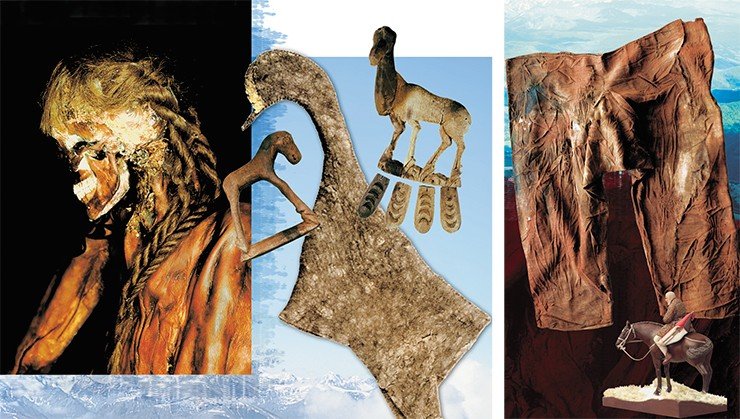
One of the important discoveries made in Ukok was the Pazyryk costume, of which virtually nothing had been known. Amazingly, the Ukok tombs have preserved the things worn during their owners’ lifetime.
The Pazyryk warrior was wearing trousers made of coarse woolen twill rather than of leather. This fabric was woven of sheep’s wool mixed with camel wool. It was dyed red using madder, a dye obtained from madder roots. The style of the trousers is very simple: two legs connected with a square piece of cloth. The trousers have traces of intense use and mending (a patch and a darn). On the waist, they were belted with a plaited woolen cord. The legs became narrower towards the bottom, and extended well below the knees. They were tucked above the knees into high felt stocking-boots with soft soles, which expanded at the upper edge. The man had a short fur coat without a collar made of finely dressed sheep skin with the fur turned inside. The man was wearing the fur coat next to his skin. An interesting detail is a 57 x 49 cm “tail” made of sheep skin and attached to the back of the fur coat. The coat was decorated with stripes of carved leather, pieces of sable fur, tassels of horse hair of red color, and black colt’s skin. The coat had neither clasps nor ties, being wrapped across the chest and secured at the waist by leather belts fastened with wooden buckles. There were two belts: one was used to suspend a felt gorit (a sheath for the bow) and the second, main belt was used to carry a battle-axe and a dagger. This tradition is of Iranian origin, as indicated by the depictions of warriors on ersepolis bas-reliefs (Iran).
The fur coat has long sleeves whose edges could be tightened with a lace. In this manner, the sleeves could have been used as pockets or bags for keeping small things (in this case, the wearer could simply slip his fur coat on). Because neither gloves nor mittens of any kind were ever found in the Pazyryk tombs, we can assume that the long sleeves that covered the wrists served as “mittens” as well. The deceased man had his arms put in the sleeves. However, on a warm day, the fur coat was cast off the shoulders and held by a belt, uncovering the tattooed chest and arms. This manner of wearing upper garments (which were often worn without any underwear) was typical of Asian cattle breeders. The ethnographers and travelers of the 19th-20th centuries reported this manner of wearing upper garments among the Tibetans, Mongols, and Altai people.
The man also was wearing a felt helmet with earflaps, which was sewn of two identical pieces tipped with a figurine of a bird’s head (the head looks like a pigeon’s head). The high tip of the helmet stood straight up owing to a special wooden framework inserted inside. The helmet is decorated with the figurines of fantasy creatures (deer and horses with horns of a wild goat) covered with gold foil. This was the first time that actual felt helmets described by Herodotus were found. He wrote that the Sakas wore high, sharp-tipped, thick hats standing straight up (Herodotus, Book VII, 64). We can see the depictions of such helmets on the Persepolian bas-reliefs and on numerous Scythian bronze art objects. Felt helmets of similar form were spread among different peoples that lived in different times and countries. However, the Pazyryk helmets differ from the known examples: they were richly decorated with fantasy creatures combining the features of deer, horse, and wild goat.
The man buried on the Ukok Plateau had light reddish hair cut in the front and forming long bangs on the forehead. On the top of his head, a large area of uncut hair was plaited into two braids, each comprised of two strands, which extended below the shoulders.
The man had a wooden neck decoration (either a personal amulet or a sign of his social status) covered with golden foil. The ends of the necklace were in the shape of snow leopard heads, his personal guardians and patrons.
The woman was wearing a long, wide woolen skirt sewn of three horizontally folded bands of material. The skirt was 144 cm long, 90 cm wide at the top, and 112.5 cm wide at the bottom. Each of the bands was dyed in different shades of red: the upper piece was scarlet, the middle band seemed not dyed, and the lower band was deep burgundy. As these colors were obtained by hand dyeing, it was quite difficult to gain the same color. The skirt was beautiful mainly because of the different colors of the bands. Moreover, both the color and number of the bands had a deep meaning and indicated the woman’s status and her affiliation with a certain community.
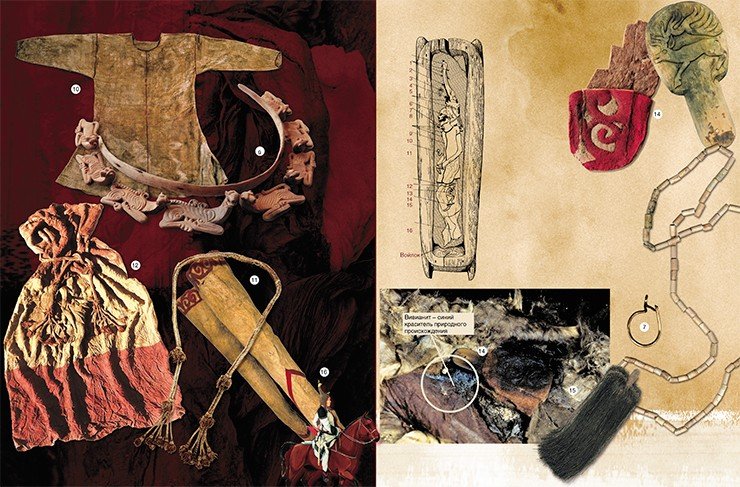
The skirt was belted with a plaited thick lace of woolen threads finished with tassels. Similar to the male trousers from Tumulus 3 (Verkh-Kaldzhin-2), the lace was dyed using madder, which yielded a red-orange color. This lace was used to regulate the length of the skirt, which could be fastened both on the waist and below the breast. We note that in many cultures plaited belts were important symbols, not just a piece of clothes, which served as talismans as well as memorial tokens used to keep important information. For example, the ancient Chinese had a secret system of tying knots on braids (jesheng) known only to the initiates. This looked like a soft belt or a braid with two tassels, each of the tassels made of six strands; each braid could have up to five knots (Stratanovich, 1965). Similar knots on the female belt from the Pazyryk tomb were obviously used as a counter (to count necessary things) or as a rosary (to remember and not miss something important).
Pazyryk women also wore knee-long light shirts with long sleeves and a round neck trimmed with red lace. In the Pazyryk tombs, three shirts have been found so far (one of them in fragments). It is surprising that in those remote times, when there were no fashion magazines to spread ideas about the style and details of clothes, ancient people made their shirts in the same style: the decoration principles and the cut of the shirts found in the Altai Mountains were identical to those found at the sites in Xinjiang oases. The female shirts from the Pazyryk tombs were made of tussah silk (or wild silk) and cotton. These are the earliest examples of tussah silk of non-Chinese origin (the Chinese started producing silk fabrics from domesticated silk worms in the third millennium B. C.). This tussah silk was presumably manufactured in non-Chinese states (south of modern China) or in Assam (modern India) that had been culturally affiliated with South-East Asia since early times. Cotton fabrics from the Pazyryk tombs are quite coarse. They must have been manufactured in the above-mentioned regions (it is of interest that Indian weavers were famous for their fine muslins). These regions are natural habitats of the two species of silkworms that produce wild silk, tussah.
The upper female garments were richly decorated, light fur coats with long narrow sleeves and a tail on the back side. The fur coats were ornamented with leather appliqué and stripes of colored fur. The designs on clothes included animal images for protection and recognition purposes. Pazyryk women, as well as men, wore long (above the knee) stocking-boots of white felt decorated with appliqué made of felt.
The composition and structure of the female wig was a complete surprise. The woman shaved her head to wear the wig. The frame for the wig was a skin-tight felt hat with two layers of hair sewn on top. A special black pliant mass was applied between the layers of hair to form the shape and volume of the wig.
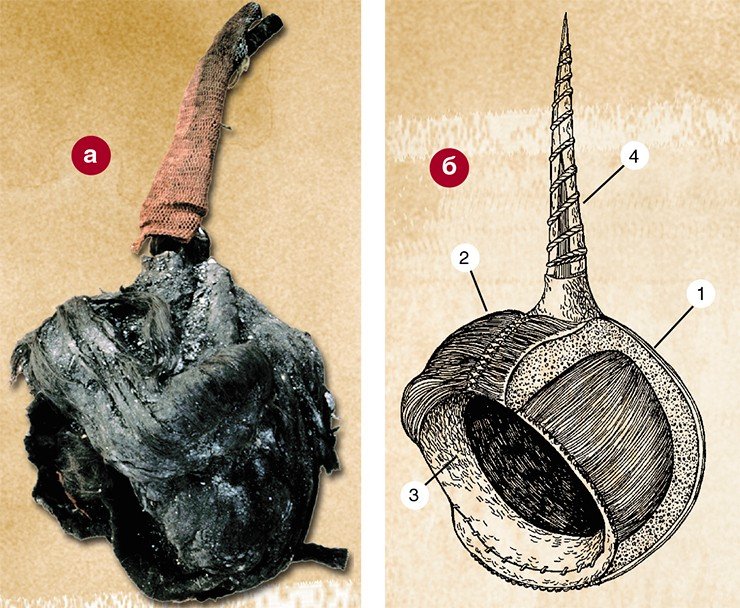
Analyses of the form-shaping material revealed the chemical composition of the filling substance and made it possible to reconstruct the technique of making a wig. The ductile components of the form-shaping material were acylglycerides (fats) and products of their decomposition, fatty acids and acrolein, a substance with a strong, specific odor. The absence of unsaturated fatty acids with conjugated double bonds or with a methylene group between the pairs of double bonds suggests that the fat used for the wig was of animal rather than vegetable nature. The form-shaping material also included some inorganic components, such as clay. Because of the excellent ductile characteristics of clay and fat, this mass was used as a form-shaping substance for the headdress.
The woman who had the honour to be buried in a separate kurgan, together with six richly decorated horses, was undoubtedly above the ordinary run of mankind. Her status might even have been higher: the women from the Pazyryk kurgans accompanied the dead tribe leaders while the woman buried in Ukok was accompanied herself and was buried with honors intended only for her. It is to be supposed that she owed this to her personal qualities.
A long time ago Lev Gumilev wrote in a fit of anger, “To measure an alien culture by the number of secure monuments is entirely wrong. There may be a magnificent civilization built on the basis of non-persistent materials like leather, furs, tree and silk, and a primitive one that uses stone and noble metals. The former will leave no trace while the latter will abound in artifacts.” A good example to this statement is the findings from the “frozen” graves of Gorny Altai: had it not been for them, what would we have found even in the biggest and richest of the Pazyryk graves? Clay vessels, bits of gold foil, iron bridle-bits, buckles and knives, plain earrings, sometimes a few beads, cowries, bronze mirrors and poorly preserved iron daggers in men’s graves…In fact, nothing that makes the essence of this culture.
The woman’s burial in Tumulus 1 of Ak-Alakha 3 site as well as some other tombs of Ukok are important not only because some unique things made of organic materials have been preserved in them (these can be found both in the large Pazyryk, Bashadar, Tuektin, and Berel barrows and in the regular burials of South-Western Altai explored by V.D. Kubarev) but also because of their unimpaired interconnection. It is the latter circumstance that makes these burial complexes so valuable, informative and unlike any others.
References
Barkova L. L. and Pankova S. V. Tatuirovka na mumiyakh iz Pazyrykskih kurganov v infrakrasnykh luchakh (Tattoos on mummies from Pazyryk mounds in infrared light) // Vest. Istor. Liter. Iskusstva, vol. 3, 2006, pp. 31—42 [in Russian].
Mirsky M. B. Kkirurgiya ot drevnosti do sovremennosti. Ocherki istorii (Surgery from Antiquity to Modern Times: Studies in the History). Moscow: Nauka, 2000 [in Russian].
Polosmak N.V. Vsadniki Ukoka (The Riders of Ukok). Novosibirsk: Infolio-Press, 2001 [in Russian].
Rudenko S.I. Kul'tura naseleniya Gornogo Altaya v skifskoe vremya (The Culture of the Gorny Altai Population in the Scythian Period), Moscow, 1953 [in Russian].
Eliade M. Shamanizm: arkhaicheskie tekhniki ekstaza (Shamanism: Archaic Ecstasy Techniques) Kyiv: Sofiya, 2000 [in Russian].
Molodin V. I., Polosmak N. V., Chikisheva T. A. et al. Fenomen altaiskikh mumii (The Phenomenon of the Altai Mummies). Novosibirsk: Inst. Arkheol. Etnogr. Sib. Otd. Ross. Akad. Nauk, 2000 [in Russian].
Polosmak N. V. and Barkova L. L. Kostyum i tekstil' pazyryktsev Altaya (IV—III vv. do n. e.) (Costume and Textiles of the Altai Pazyryks (4th—3rd centuries BC)). Novosibirsk: INFOLIO, 2005 [in Russian].
Polosmak N. V., Kundo L. P., Korolyk E. A. et al. Tekstil' iz «zamerzshikh» mogil Gornogo Altaya IV—III vv. do n. e. (opyt mezhdistsiplinarnogo issledovaniya) (Textiles from the “Frozen Graves” of the Altai Mountains in the 4th to 3rd Centuries BC (An Interdisciplinary Study)). Novosibirsk: Sib. Otd. Ross. Akad. Nauk. 2006 [in Russian].
Chikisheva T.A., Polosmak N.V., and Zubova A.V. The burial at Ak-Alakha-3 Mound 1, Gorny Altai: new findings // Archaeology, Ethnology and Anthropology of Eurasia, vol. 43, Issue 1, March 2015, pp. 144–154.
Pilipenko A.S., Trapezov R.O., and Polosmak N.V. A genetic analysis of human remains from Ak-Alakha-3 burial mound 1, Gorny Altai // Archaeology, Ethnology and Anthropology of Eurasia, vol. 43, Issue 2, June 2015, pp. 138–145.
Letyagin A.Yu., Savelov A.A., and Polosmak N.V. High field magnetic resonance imaging of a mummy from Ak-Alakha-3 Mound 1, Ukok Plateau, Gorny Altai: findings and interpretations // Archaeology, Ethnology and Anthropology of Eurasia, vol. 42, Issue 4, December 2014, pp. 83–91.
Pilipenko A.S., Trapezov R.O., and Polosmak N.V. A paleogenetic study of Pazyryk people buried at Ak-Alakha-1, the Altai Mountains // Archaeology, Ethnology and Anthropology of Eurasia, vol. 43, Issue 4, December 2015, pp. 144–150.


